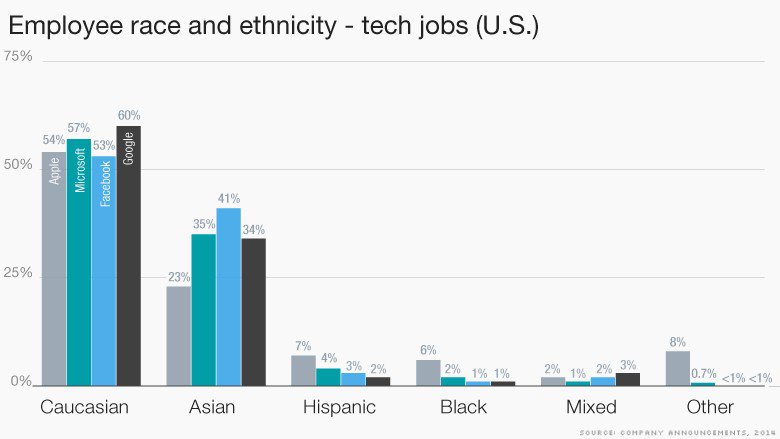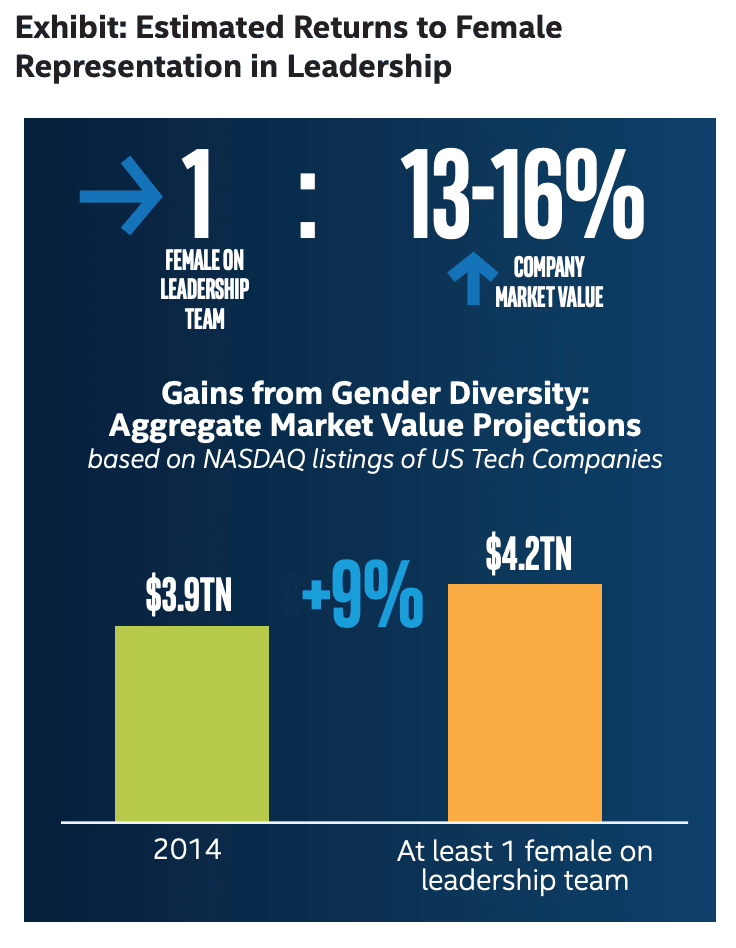Por que a diversidade e a representação são importantes no setor de tecnologia
Diversidade: algo sobre o qual o mundo da tecnologia vem falando há décadas. Há painéis em conferências, livros, podcasts e muito mais dedicado ao tema.
No entanto, os números ainda são bastante desanimadores.

Marginalized groups – namely women and minorities – are still severely underrepresented in tech.
Por que isso acontece? E como podemos consertar isso?
Let’s explore. 👇
O dilema da diversidade
Se você observar algumas das principais empresas do Vale do Silício, elas são predominantemente masculinas e predominantemente brancas (com a grande maioria das empresas tendo uma força de trabalho que é menos de 10% negra e/ou latina).
Of the $85 billion invested by venture capitalists in 2017, only $1.9 billion went to women-led teams – that’s 2.2% in total. 👎
E mesmo as equipes de gênero misto (ou de gênero não confirmado) arrecadaram apenas 19% desse valor de $85 bilhões.
When it comes to the racial disparities in funding, there’s a wide gap in the number of black and Latinx investment professionals who work at VC funds – the number was as low as 3% in 2016.
And we haven’t even mentioned the pay gap yet. 💸
As mulheres em profissões STEM ganham, em média, $16.000 a menos por ano do que seus colegas homens.

Ou, se você é negro ou latino e trabalha em uma profissão STEM, pode estar ganhando $14.000 a menos do que seu colega de trabalho branco.
Noticing a pattern? 🤔
Como chegamos até aqui?
If we look at Emily Chang’s Brotopia, an insightful and well-researched book that chronicles the major gender disparities in Silicon Valley, it wasn’t always this way.
By the time the Macintosh was introduced in the 1980s, women were earning 40% of computer science degrees. 👩💻
Nesse ponto, havia várias mulheres pioneiras em tecnologia. Afinal de contas, a primeira linha de código de computador foi escrita por Ada Lovelace na década de 1840.
Mas então houve uma mudança.

“Just as computers began to head into the mainstream, women’s participation in the field started to plummet,” Chang writes.
Na última década, aproximadamente, a porcentagem de mulheres que se formaram em ciência da computação permaneceu estável em torno de 22%.
É claro que há uma infinidade de fatores em jogo aqui.
It goes beyond sexism or racism. There are microaggressions happening all the time in tech company offices – what’s frustrating about this is that it can sometimes be hard to pinpoint or call out.
Por exemplo, as engenheiras enfrentam 35% mais rejeições de seus códigos.
And from an anecdotal standpoint, another example would be infamous VCs holding parties that would make women uncomfortable, though of course, to men, it’s just a way for them to see if entrepreneurs can “hang.”
A falta de modelos pode ser outro fator. Há muito, muito poucas mulheres e minorias nos altos escalões das empresas de tecnologia.

It can also be chalked up internalized doubt. Many marginalized people, if not all in some way or another, are socialized and educated in subtle ways throughout their lives to doubt themselves (thankfully, this is being tackled by organizations such as Endeavor – check it out!).
This can often come in the form of “Impostor Syndrome,” a phenomenon that describes the feeling of being undeserving of your success, an “impostor.”
O fenômeno afeta desproporcionalmente as mulheres e as minorias, mas em uma cultura empresarial que incentiva as pessoas a venderem ideias e inflacionarem seu valor, isso é problemático.

There are, of course, many other tangible and intangible factors as well. A person’s upbringing can greatly impact the way they perceive their career path.
For example, something seemingly harmless such as giving dolls to young girls and Legos to young boys can further exacerbate outdated gender roles. 🙅♀️
Mas, com tudo isso dito, como seria o mundo da tecnologia se ele fosse mais diversificado?
There’s truth in the numbers
Beyond the obvious “it’s the right thing to do” mindset of having more diversity and representation in the tech world, it also just makes good business sense.
A study from McKinsey & Company found that companies in the top quartile for gender or racial and ethnic diversity are “more likely to have financial returns above their national industry medians.”
E o quartil inferior dessas dimensões? Eles têm estatisticamente menos probabilidade de obter esses retornos.

As mentioned in their findings, “diversity is probably a competitive differentiator that shifts market share toward more diverse companies over time.”
From a financial standpoint, according to Forbes, female tech entrepreneurs are able to generate 20% more revenue than their male counterparts – despite starting their companies with 50% less capital. 💪
On top of that, the European Commission calculates that through the further inclusion of women working in tech, the EU’s GDP could see an annual boost of €16 billion.
The numbers are even more incredible in the US. In Intel’s Decoding Diversity report, they concluded, as we’ve already seen, that diversity leads to higher revenues, profits and market value.

Mas ele vai ainda mais longe: ao melhorar a diversidade e inclusão étnica e de gênero na força de trabalho de tecnologia dos EUA, ele poderia criar entre $470 bilhões e $570 bilhões em novo valor para o setor.
That’s a lot of zeros. 😲
Indo além dos números
Então, por que exatamente a diversidade traz melhores resultados?
Porque a similaridade mata a inovação.
Ter diversidade na forma como suas equipes pensam e resolvem problemas gera maior sucesso.
Uma melhor representação dos grupos marginalizados é fundamental para encontrar as soluções certas para os desafios, o pensamento criativo e o sucesso geral do cliente.
Quando os membros da equipe são muito parecidos, as coisas podem ser perdidas ou negligenciadas.
Let’s put it this way: diverse teams win more often and more consistently.
Além disso, ter equipes mais diversificadas significa que sua empresa está atendendo a todos os clientes, não apenas a si mesma.
O mundo está repleto de pessoas com uma infinidade de origens e perspectivas. Para criar e desenvolver um negócio que atenda a todos, as equipes precisam ouvir aqueles que têm uma variedade de experiências.
Para onde vamos a partir de agora?
There are already some companies and government organizations that are pushing for more representation in the tech industry – but it needs to go further (and not just result in simple quotas).
Going back to Cheng’s Brotopia, she suggests:
- nomeação de mulheres para as diretorias,
- contratação de mais mulheres sócias
- e contratar mais mulheres capitalistas de risco.
- O mesmo deve ser feito para todos os grupos marginalizados, é claro.
But most importantly: the tech industry needs to stop blaming everyone else for the problem. 😕
No Vale do Silício, o fracasso é algo celebrado, pois pode ajudá-lo a aprender (e, por fim, a ter sucesso). No entanto, os grupos marginalizados têm sido reprovados pelo setor de tecnologia há muito tempo.

As Cheng explains, “it’s time for the industry to own it.”
Os dados provaram repetidamente que uma força de trabalho mais diversificada não é apenas mais eficiente e lucrativa, mas também oferece às empresas a chance de ouvir perspectivas que não estavam presentes anteriormente.
It’s crucial for companies to have more intersectional voices heard across the tech industry, especially in leadership functions, and to encourage more diversity to ensure that they are creating solutions and technology for the modern world: one that is filled with people from different walks of life.
Vamos resolver o problema com esta única postagem de blog? Claro que não.
But we need to be having these conversations. And more importantly, we need to be doing something about it. 🗣

We can speak at diversity panels until our faces turn blue, but until those in the higher echelons of the tech world encourage and drive the conversation – and take meaningful actions for change – things are going to remain the status quo.
And, well, that’s just bad business. 🤷♀️
Esperamos que você tenha gostado desta postagem. Se gostou, espalhe a notícia!
Para obter mais informações importantes sobre startups, marketing de crescimento e vendas:
👉 follow @salesflare on Twitter ou Facebook
- 22+ melhores podcasts de vendas que você deve conferir em 2024 - dezembro 21, 2023
- Scripts de chamadas frias para seres humanos reais - 21 de setembro de 2023
- As 25+ melhores ferramentas de vendas para ajudar sua equipe a ser bem-sucedida - agosto 10, 2023
